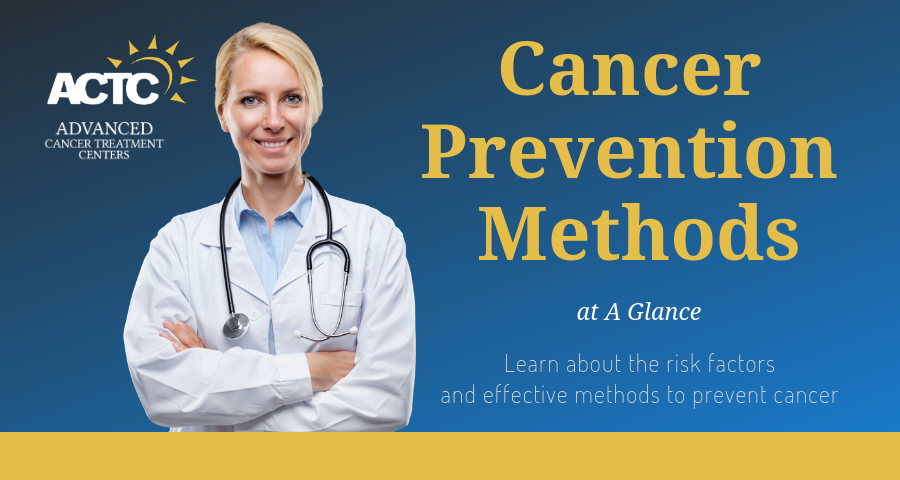
Book a Consultation
Thank you!
Your form has been sent successfully.



March 25, 2021
Cancer may afflict anyone, at almost any point during their life. According to a report by The National Cancer Association, 1 in 3 Americans will develop cancer within their lifetime - more than 1.7 million are expected to be diagnosed in 2019 alone. Despite those harrowing statistics, research has armed patients and practitioners alike with the evidence and tools they need to fight back.
In this article, you’ll learn about the associated risk factors as well as effective methods to help prevent cancer.
These statistics are paramount in understanding why it’s so prudent to address the risk factors in your life that increase your odds of developing cancer.

A common misconception is that cancer has an overwhelming genetic component. While unpreventable causes like genetic inheritance can contribute to incidences, we know that cancer is often caused by environmental factors.
Tobacco is the leading preventable cause of many cancers, including (but not limited to) 1 in 9 incidences of lung cancer. Use can also cause throat, bladder, pancreatic, blood, liver and stomach cancer. The list goes on, and the risk also extends to non-smokers; more than 7,000 lung cancer deaths attributed to secondhand smoke each year.
Other common causes of cancer include:
Prevention
There are several aspects of prevention ranging from screening to lifestyle changes that dramatically reduce your risk of developing cancer.
Regular Screenings
It is important to undergo regular screenings to detect cancer before it has a chance to grow. Often when cancer is detected early, the chances of survival are improved greatly.
Annual screenings for lung cancer via a low-dose CT scan (LDCT) are recommended for high-risk populations including men and women age 55-74, those who currently smoke or have quit smoking within the past 15 years and cigarette smokers who have at least a 30 “pack-year” smoking history. A pack-year is equivalent to 1 pack of cigarettes per-day for every day of a year.
Colorectal cancer screenings should begin in high-risk individuals at age 45 and continue until age 75, unless otherwise recommended by their doctor. These tests range from colonoscopy to stool examination.
Women over 40 should start scheduling annual breast cancer screenings that include mammograms. It’s recommended that women perform self breast exams and notify their doctor if they discover any abnormalities. In addition, women should start undergoing regular screenings for cervical cancer at age 21 even if they’ve received the HPV vaccine.
Men over 50 should consider talking to their doctor about the benefits of screening for prostate cancer. If testing is undergone, a PSA blood test should be performed whether or not it’s accompanied by a rectal examination. Testing frequency is usually dependent on PSA levels.
Lifestyle Intervention
About 1 in 3 cancer deaths are attributed to cigarette smoking. Discontinuing use of tobacco can reduce your risk of developing cancer significantly, but quitting can be a daunting challenge. Thankfully, there are several resources for quitting including pharmaceutical interventions and support groups. As noted earlier, smoking impacts more than just smokers. Secondhand smoke is a major risk factor so by quitting, you’re doing everyone (including your family and neighbors) a huge favor.
There is evidence that conditions associated with obesity and being overweight contribute to cancer risk greatly. Altered or weakened immunity is prevalent among obese people, making them susceptible to infections and subsequent alteration to cell growth and proliferation. Fat cells exert a powerful effect on many growth regulatory mechanisms and excess body fat correlates with an increased risk of developing many different types of cancer including breast and colorectal cancer. Chronic inflammation may cause damage to DNA that can lead to cancer. Likewise, metabolic diseases like diabetes and insulin resistance may contribute to cancer indirectly as well.

It’s recommended that you adhere to diet and exercise protocols that keep your Body Mass Index (BMI) within the normal range and that you maintain a relatively low body fat percentage throughout your life. The World Cancer Research Fund has dietary recommendations posted here. Limiting calorie intake, consuming a wide variety of fruits, grains, and vegetables and engaging in regular exercise like walking and resistance training are great ways to keep your BMI down and your body fat low. Along with a healthy diet and regular exercise, avoiding the use of alcohol and elicit substances is highly recommended.
Finally, you should protect yourself against exposure to harmful UV radiation, follow all safety guidelines for handling chemicals in the workplace and at home and limit your exposure to environmental hazards like smog, mold and contaminated water.
There is no guaranteed way to prevent cancer but being aware of the risk factors present in your environment, taking a proactive approach to screening, and living a healthy lifestyle can improve your chances of survival. As of this writing, there are over 15 million cancer survivors in the U.S. alone and mortality rates are at an all-time low. If you or a loved one are at risk, the time to talk to your doctor and begin making changes is now.


November 13, 2025
Food choices feel high-stakes during cancer care, and because of that,...
KNOW MORE

November 13, 2025
Ablation treats prostate cancer using energy such as heat, cold, elect...
KNOW MORE

November 13, 2025
Discovering a fast-growing bump on your skin can cause immediate worry...
KNOW MORE

November 13, 2025
Triple negative breast cancer (TNBC) is one of several kinds of breast...
KNOW MORE

June 03, 2024
The last decade has witnessed a sea change in oncologic treatments. Re...
KNOW MORE

April 17, 2024
Oncology is one of the most exciting fields in medicine today. Disease...
KNOW MORE
